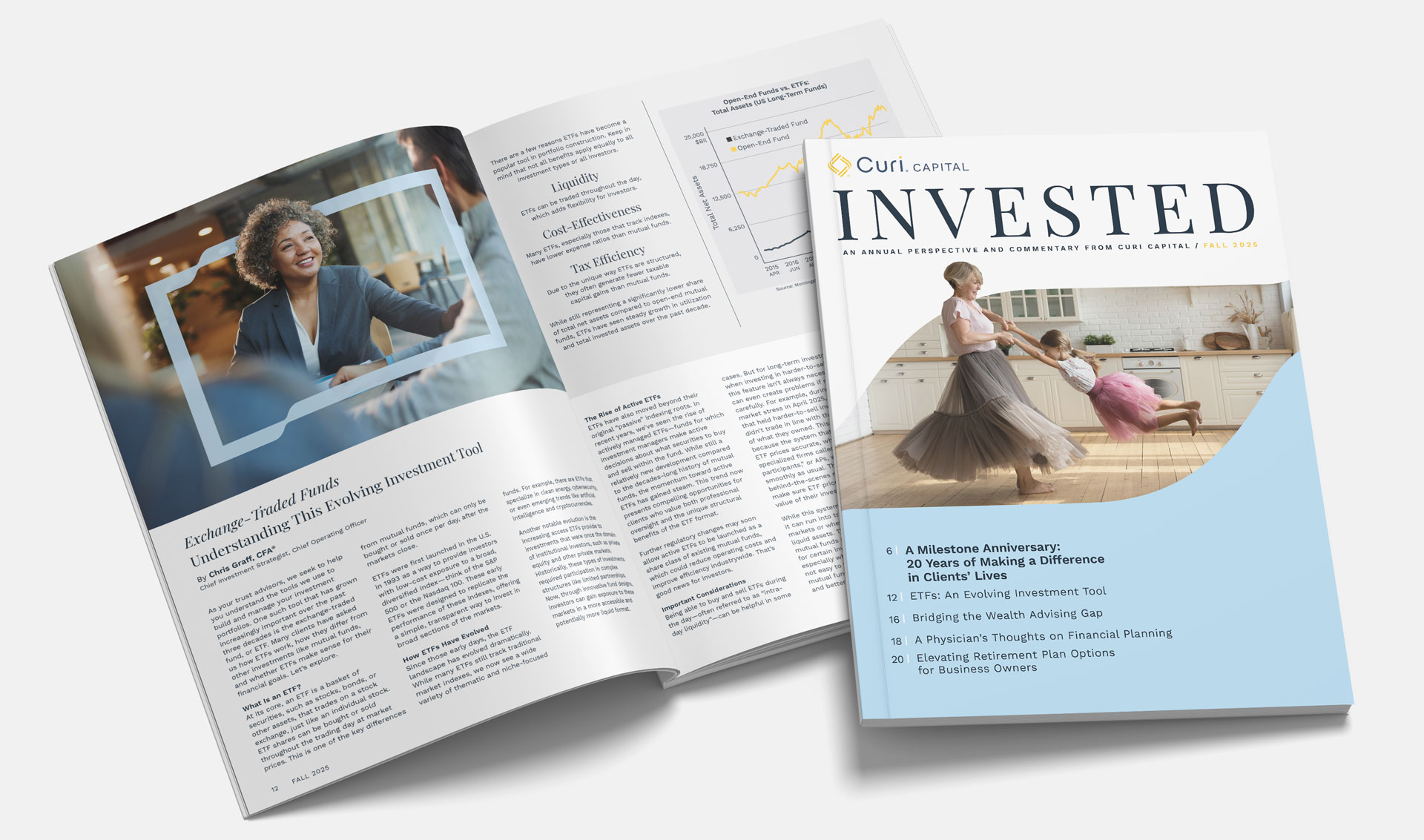Key Takeaways
- Women now control more than half of U.S. wealth and are expected to inherit the majority of the $124 trillion projected to transfer through 2048.²
- Women give more than men—not just money, but also time and expertise—and often approach giving with collaboration, strategy, and a long-term view.¹
- Philanthropy can include donations, volunteering, and board service – often called the 3T: Time, Talent, and Treasure.
- Women are more likely to support causes promoting gender equality, racial justice, and social equity.¹
- Philanthropy and financial planning go hand-in-hand. Thoughtful strategies allow you to make a meaningful impact today while creating a lasting legacy and maximizing tax benefits.
Women and Wealth: Expanding Influence
Over the past few decades, women have steadily increased their financial influence, gradually gaining control over a larger share of wealth. Today, they hold roughly one-third of U.S. household financial assets—about $10 trillion—and 40% of global wealth.² This growth is expected to accelerate during the next several decades through the “Great Wealth Transfer,” where women are projected to inherit the majority of the $124 trillion in U.S. wealth transferring through 2048.²
Much of this change is being driven by younger women, who are increasingly confident in managing investments, making household financial decisions, and often serving as primary earners.² This growing financial sophistication means women are in a stronger position than ever to shape philanthropy and make a lasting difference in the world.
Women Give More—and Differently
When we talk with our clients, we often see that women approach giving with intention, care, and a personal connection to the causes they support. Research confirms that women give thoughtfully and strategically, combining heart with impact.¹
Women often take the lead in philanthropy, supporting a wide range of causes on their own initiative. In fact, 85% of affluent household charitable giving decisions are made or influenced by women.³ Research also shows that single women are more likely to give than single men and often support a broader range of causes. When married, women frequently socialize their spouses into giving, creating a shared sense of purpose and collaboration that extends the impact of their household philanthropy.¹
Another hallmark of women’s giving is its breadth. Contributions are often spread across multiple organizations, allowing their generosity to touch a wider circle of communities and causes.¹
Women also tend to focus on causes that advance social impact, such as gender equality, racial equity, and community development.¹ Their giving often reflects long-term thinking, careful consideration of opportunities, and a desire to understand the outcomes of their contributions. In short, women’s philanthropy is intentional, collaborative, and deeply personal. It blends heart with strategy, turning giving into a purposeful way to create lasting impact.
The 3T Approach: Time, Talent, Treasure
Women’s giving often reflects a balance of time, talent, and treasure—a framework that shows how philanthropy can extend far beyond financial contributions.
- Time: Women frequently volunteer and engage directly with the organizations they support, offering hands-on assistance and a personal connection to the causes they care about.
- Talent: They bring professional skills, expertise, and experience to help organizations thrive, whether it’s serving on boards, offering strategic guidance, or lending specialized knowledge.
- Treasure: Financial contributions remain an important piece, from one-time gifts to long-term commitments, often structured thoughtfully to maximize impact.
By combining these three elements, women create a holistic approach to giving that leverages all their resources. This approach not only strengthens the organizations they support but also ensures their philanthropy reflects both heart and strategy.
Getting Started with Purposeful Giving
For many women, the first step in philanthropy is identifying the causes that resonate most personally. Whether it’s education, social justice, the arts, or community development, giving becomes most meaningful when it aligns with your values and passions.
Working with a financial advisor can help turn those passions into a strategy. Your Curi Capital team can guide you in making your giving both impactful and tax-efficient, exploring options such as establishing a donor-advised fund or gifting non-cash gifts like highly appreciated securities. Thoughtful planning can also help you create a legacy, ensuring your generosity continues through estate planning or bequests. Learn more about common charitable giving vehicles.
The key is to approach giving intentionally. By combining careful planning with your own values, interests, and expertise, your philanthropy can have a deeper, more lasting impact—for the causes you care about and for the communities you support.
FAQ
1. How do I decide which causes to support?
Start with what matters most to you. Consider your personal passions, values, and the issues that resonate with your life experiences. Advisors can help you align those priorities with giving strategies to maximize impact.
2. What’s the best way to make my giving both impactful and tax-efficient?
Your Curi Capital advisor can assist you with creating a giving plan that considers your short- and long-term goals, assets and investments, and tax status. Learn more about honing your charitable giving strategy with this helpful guide.
3. How can I involve my family in giving?
Many women find it rewarding to include spouses, children, or other family members in philanthropic decisions. This can be as simple as discussing priorities together, volunteering as a family, or establishing a shared giving fund.
4. Should I focus on short-term or long-term commitments?
Both have benefits, but women often prefer long-term, strategic commitments that allow organizations to plan ahead and increase impact. Your advisor can help determine the right mix for your goals.
5. How do I evaluate organizations to ensure my contributions make a difference?
Consider factors like the organization’s mission, financial health, transparency, and evidence of impact.
6. How does recent tax legislation impact charitable giving?
The “One Big Beautiful Bill” (OBBB), signed in 2025, allows non-itemizers to deduct cash donations up to $1,000 for single filers and $2,000 for joint filers.4 This encourages broader charitable participation and may influence the timing and strategy of donations, so consulting your Curi Capital advisor can help optimize your giving.
7. Can philanthropy be part of my overall financial plan?
Absolutely. Integrating giving with financial planning ensures that your contributions are sustainable, strategic, and aligned with your long-term financial and legacy goals.
1. Women’s Philanthropy Institute at Indiana University. Women Give More: Gender Differences in Philanthropy. https://scholarworks.indianapolis.iu.edu/server/api/core/bitstreams/37b6e23d-6139-47bb-a9a7-aab08c0e66dc/content
2. McKinsey & Company. Women as the next wave of growth in US wealth management. https://www.mckinsey.com/industries/financial-services/our-insights/women-as-the-next-wave-of-growth-in-us-wealth-management
3. Bank of America Private Bank. 2023 Study of Women and Philanthropy. https://www.privatebank.bankofamerica.com/articles/2023-bank-of-america-study-of-philanthropy.html
4. Fidelity Charitable. One Big Beautiful Bill (OBBB): Impact on charitable giving. https://www.fidelitycharitable.org/articles/obbb-tax-reform.html
Disclaimers
The opinions and analyses expressed in this newsletter are based on Curi Capital, LLC’s (“Curi Capital”) research and professional experience are expressed as of the date of our mailing of this newsletter. Certain information expressed represents an assessment at a specific point in time and is not intended to be a forecast or guarantee of future results, nor is it intended to speak to any future time periods. Curi makes no warranty or representation, express or implied, nor does Curi accept any liability, with respect to the information and data set forth herein, and Curi specifically disclaims any duty to update any of the information and data contained in this newsletter. The information and data in this newsletter does not constitute legal, tax, accounting, investment or other professional advice. Returns are presented net of fees. An investment cannot be made directly in an index. The index data assumes reinvestment of all income and does not bear fees, taxes, or transaction costs. The investment strategy and types of securities held by the comparison index may be substantially different from the investment strategy and types of securities held by your account.
The content contained herein was generated by Curi Capital with the assistance of an AI-based system to augment the effort.
Certified Financial Planner Board of Standards, Inc. owns the certification marks CFP®, CERTIFIED FINANCIAL PLANNER™ and federally registered CFP (with flame design) in the U.S., which it awards to individuals who successfully complete CFP Board’s initial and ongoing certification requirements.



